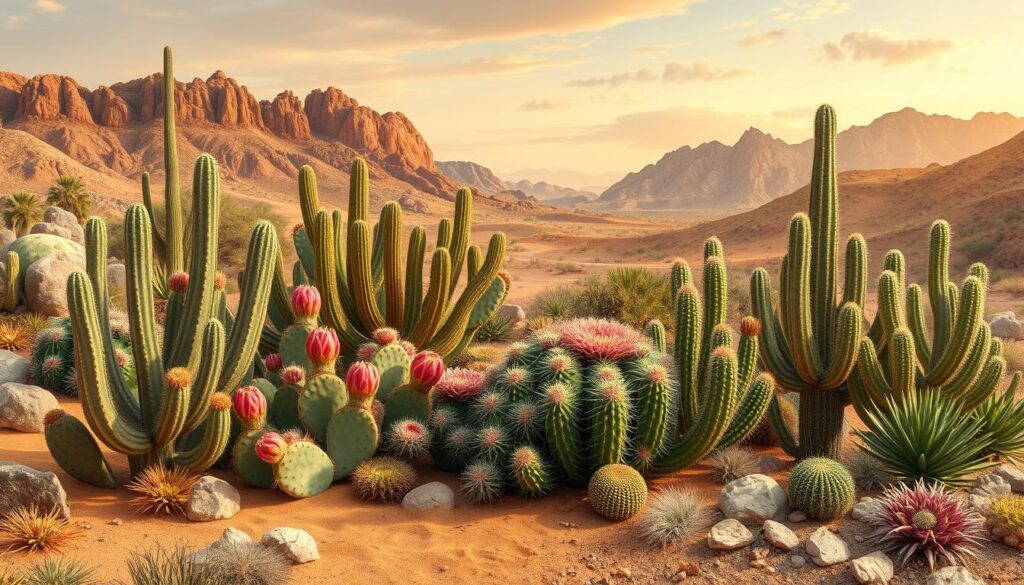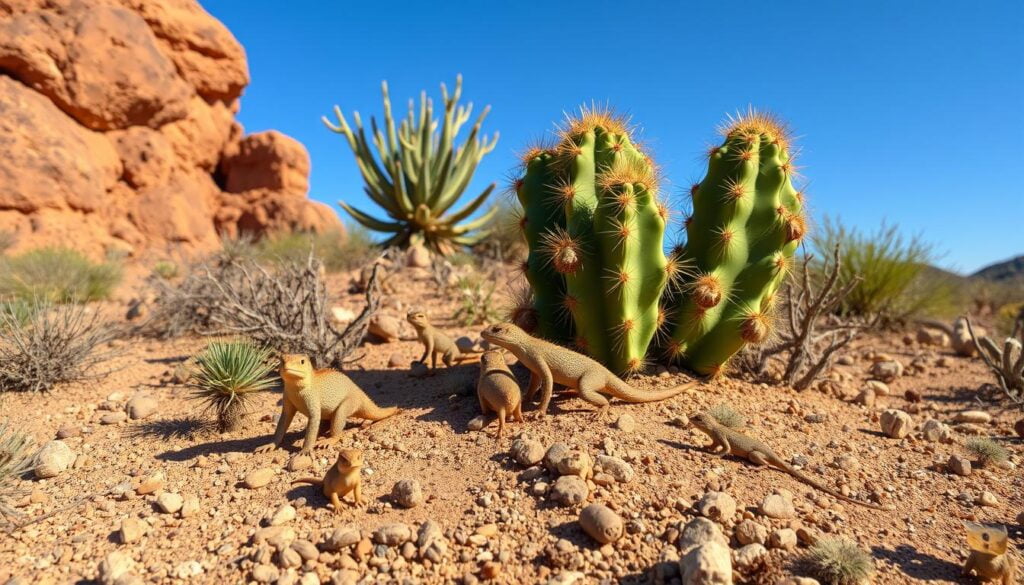Imagine a world where plants not only survive but thrive in harsh environments. This is the world of Opuntia, also known as prickly pear cacti. These desert plants are known for their vibrant flowers and tough pads. They have adapted to life in dry lands, showing how they conserve water and stay strong.
Key Takeaways
- Opuntia, or prickly pear cacti, are well-adapted to survive in arid environments.
- These desert plants are known for their edible fruit and showy flowers in a variety of colors.
- Opuntia cacti can grow up to 8-15 feet tall and wide, with a slow growth rate.
- Prickly pear cacti are hardy and can withstand temperatures as low as 10°F.
- Opuntia species are found abundantly in the Western and South Central United States, as well as Mexico and the Caribbean.
Introduction to Opuntia
The Opuntia, also known as the prickly pear cactus, is a group of cacti found in the Americas. It has about 150-180 species. These plants are spread from Canada’s Peace River to South America’s tip. They are key to desert ecosystems, feeding many animals and providing homes for others.
Understanding the Genus Opuntia
Opuntia belongs to the cactus family, Cactaceae. It’s known for its flat stems called cladodes. These stems have spines and glochids that protect them from animals in dry places.
Opuntia’s Role in Desert Ecosystems
Opuntia cacti are crucial in deserts. They offer food to many desert animals like birds, mammals, and insects. Their large growth also provides shelter and nesting sites, helping to keep the desert diverse.
“Opuntia cacti are a quintessential symbol of the American Southwest, thriving in the harsh, dry conditions that characterize these desert environments.”
Botanical Classification
The Opuntia genus includes the prickly pear cactus. It falls under the Cactaceae family. This family is part of the angiosperms (flowering plants) and eudicots (true dicots) groups. Opuntia also belongs to the Caryophyllales order, a group of plants that can live in different environments.
Opuntia is a big and diverse group in the cactus family, with over 300 species across the Americas. These plants are tough and can survive without much water. They have special ways to live in the dry deserts.
- The Opuntia genus is part of the Cactaceae family, known for their spiny look.
- Opuntia cacti are angiosperms, or flowering plants, and are in the eudicots group.
- They are part of the Caryophyllales order, which has many different plants that can live in various places.
- With over 300 species, Opuntia is very common and diverse in the cactus family.
This classification shows how Opuntia cacti have adapted to live in the tough conditions of deserts in the Americas.
Distinctive Morphology
Opuntia, a group of prickly pear cacti, stands out for its unique shape and adaptability. These desert plants have flat, paddle-like parts called cladodes or stem segments. These cladodes are key for photosynthesis, measuring from 1 to 100 cm long and 0.7 to 30 cm wide.
Opuntia stems come in various shapes, from round to flat and long. They can be green, blue, purple, or red, showing the plant’s amazing adaptability.
Spines and Glochids
Opuntia plants also have spines and glochids – tiny, sharp hairs – from their areoles, special spots on the stems. Some have few spines, while others have hundreds per areole.
These spines and glochids protect the plant from animals. The glochids are hard to get off human skin, showing how well they work as a defense.
“Opuntia species are known for their unique adaptations, such as the presence of barbed spines and flattened stem segments that aid in water storage and offer protection against herbivory.”
Adaptations for Arid Environments
Opuntia, or prickly pear cacti, have evolved amazing adaptations to live in dry places. These drought-resistant plants have found smart ways to save water and survive in the desert.
Water Conservation Strategies
Opuntia’s key trick is its flat stems called cladodes. These stems lose less water because they have a small surface area. The plants also store water in their thick tissue. Their waxy coating and sunken stomata stop water from evaporating too quickly.
- Waxy coating on leaves to prevent water loss
- Spines for protection from herbivores
- Ability to store water in pads or stems
These xerophytic adaptations help Opuntia save water and survive in dry places. By losing less water and using it wisely, these tough plants show how drought-resistant plants can help with water conservation and green gardening.
“Cacti have evolved remarkable adaptations to thrive in the desert, showcasing the remarkable potential of drought-resistant plants in sustainable gardening.”
Desert Plants: Opuntia’s Resilience
The desert is tough and unforgiving, but some plants have learned to thrive there. The Opuntia, or prickly pear cactus, is one such plant. It has special ways to survive and even do well in the desert.
Opuntia can store a lot of water in its stems, called cladodes. These stems are like big pads that can hold hundreds of gallons of water. This helps the plant survive long droughts. The spines and tiny barbed hairs on the Opuntia keep animals away, saving the plant’s water.
Opuntia also has ways to save water. Its skin reflects sunlight and it closes its tiny openings during the day. This stops water from evaporating and helps the plant stay hydrated in the desert sun.
Opuntia can also handle very hot and cold temperatures. This makes it perfect for life in the desert. It’s a key plant in desert ecosystems, providing food and shelter for many animals.
Opuntia’s ability to survive in the desert shows how tough desert plants can be. Learning about these plants helps us value desert ecosystems more. We see how important they are for life in harsh places.
| Adaptation | Description |
|---|---|
| Water Storage | Opuntia species can store hundreds of gallons of water in their thick, fleshy cladodes (stem segments). |
| Spines and Glochids | The plant’s spines and small, barbed bristles (glochids) deter herbivores and conserve water. |
| Waxy Epidermis | Opuntia’s waxy, reflective outer layer helps reduce water evaporation. |
| Stomatal Regulation | Opuntia can close its stomata during the day to prevent excessive transpiration. |
| Temperature Tolerance | Opuntia can withstand both scorching heat and occasional frost, making them well-suited for diverse arid landscapes. |
Opuntia’s toughness shows how well desert plants can adapt. By learning about these plants, we can see how important they are. They help make desert ecosystems work and support life in tough places.
“The saguaro cactus found in the Sonoran Desert can live for over 150 years, demonstrating the remarkable longevity and resilience of desert plants.”
Geographical Distribution
The prickly pear cactus, known as Opuntia, is native to the Americas. It’s most diverse in Mexico and the Caribbean. In the U.S., these plants do well in the dry areas of the West and Southwest. This includes the Sonoran, Mojave, and Chihuahuan Deserts.
Native Habitats
Opuntia species thrive in the tough desert environments of the Americas. They live in many places, from the Southwest’s rocky canyons to the Caribbean’s dry coasts. These cacti have adapted to the desert’s heat, little rain, and big temperature changes.
Introduced Regions
Humans have also brought prickly pears to places like the Mediterranean, South Africa, and Australia. In these areas, they can be invasive, taking over from native plants and changing ecosystems. Their ability to live in different climates has helped them spread around the world, sometimes on purpose, sometimes not.
| Region | Native Habitats | Introduced Regions |
|---|---|---|
| Americas |
|
|

Opuntia species are found in many places, both where they’re native and where they’ve been introduced. Their ability to adapt to different climates and places shows how tough and resilient they are. These desert plants play a big role in many ecosystems around the world.
Culinary and Commercial Uses
The Opuntia genus, also known as prickly pear, has a long history in food and business around the world. The most grown species is Opuntia ficus-indica, or Barbary fig. It’s mainly raised for its tasty fruits and pads.
Edible Fruits and Pads
The fruits of Opuntia, called “tuna,” are a key food for desert people like the Salado. They are sweet and eaten fresh, juiced, or made into jams and drinks.
The pads, or “nopales,” are also eaten and used in many dishes. They can be cooked grilled, sautéed, or added to salads and tacos.
| Nutrient | Opuntia ficus-indica | Other Common Foods |
|---|---|---|
| Protein | 1.2-2.0 g/100g | Apples: 0.3 g/100g, Bananas: 1.1 g/100g, Oranges: 0.9 g/100g |
| Fiber | 3-5 g/100g | Oranges: 2.4 g/100g, Bananas: 2.6 g/100g, Apples: 2.4 g/100g |
| Calcium | 220-320 mg/100g | Apples: 6 mg/100g, Bananas: 5 mg/100g, Oranges: 40 mg/100g |
| Ascorbic Acid | 5-40 mg/100g | Bananas: 8.7 mg/100g, Oranges: 53.2 mg/100g, Apples: 4.4 mg/100g |
Opuntia’s nutritional values make it a great food option. It has more protein, fiber, calcium, and vitamin C than apples, bananas, and oranges.
Opuntia species also have commercial uses. They are used as natural thickeners, bioplastics, and edible coatings. They are also in gluten-free foods, dips, and salad dressings.
Ecological Importance
Opuntia plants, also known as prickly pears, are key to desert ecosystems. They are tough and can survive without much water. These plants are a main food source for many desert animals, making them crucial to the desert food chain.
Food Source for Desert Fauna
Many desert animals eat the fruits, pads, and even spines of prickly pears. Animals like the Gila monster and the desert bighorn sheep rely on them for food and water in the desert.
The pads of these plants are a favorite snack for desert animals. The fruits, or tunas, are also eaten by birds and other animals. They are a key food source during the dry and hot seasons.
| Desert Fauna | Opuntia as Food Source |
|---|---|
| Gila Monster | Pads and Fruits |
| Desert Bighorn Sheep | Pads |
| Cactus Wren | Fruits |
| Desert Tortoise | Pads and Fruits |
| Black-tailed Jackrabbit | Pads |
Opuntia plants are a food source for many desert fauna. They help keep the balance in desert ecosystems. Their presence supports the diverse life in these dry places.

Taxonomy and Species Diversity
The study of Opuntia’s taxonomy is both complex and fascinating. These desert plants show a wide species diversity with over 200 types found globally. Their ability to hybridize adds to their complex family tree.
Many Opuntia species are polyploid, meaning they have more than the usual number of chromosomes. Most start with 2n=22 but some have evolved to have 6n=66 or 8n=88 chromosomes. This variety helps them adapt and survive in the desert.
“High plant diversity is necessary to maintain ecosystem services.”
Opuntia is a great example of how taxonomy and species diversity work together. Knowing about these plants is key for saving them and keeping deserts healthy. Opuntia is crucial to the balance of desert ecosystems.
In the Gurbantunggut Desert of northwestern China, researchers found 92 plant species over 61 sites. Factors like rain, land shape, and soil type affect how many plants live there. This shows why we must protect Opuntia’s homes to keep the desert ecosystem healthy.
Threats and Conservation
Opuntia species have thrived in the desert for a long time. But now, they face threats from invasive species and climate change. In Australia, for example, prickly pear Opuntia has become a problem, leading to efforts to control it.
Invasive Species Concerns
When non-native Opuntia species were introduced, it caused big problems. These invasive prickly pears harm desert ecosystems. They take over and push out native plants, upsetting the balance of life in the desert.
Conservationists are fighting to stop these invasive Opuntia. They have programs to get rid of them and manage their spread. This helps protect the desert and its unique plants and animals.
Defenders, an environmental group, is part of this fight. They work with agencies to make plans for conservation. These plans help endangered desert species, including those that rely on Opuntia.
| Threat | Impact | Conservation Efforts |
|---|---|---|
| Invasive Opuntia species | Disruption of desert ecosystems, outcompeting native plants | Eradication and management programs, integrated conservation planning |
| Climate change | Reduced precipitation, increased temperature, and changes in habitat suitability | Monitoring of environmental conditions, habitat restoration, species-specific recovery plans |
Defenders also focus on how climate change affects the desert and Opuntia. They watch the weather and soil to see how it impacts endangered plants. This includes the Eureka Dunes evening primrose and Eureka Valley dune grass.
Conservationists are working hard to protect these desert plants and their homes. They use science and partnerships to fight against invasive species and climate change. Their goal is to keep Opuntia and the desert safe for the future.
Conclusion
Opuntia, the prickly pear cactus, shows us how desert plants can thrive in tough conditions. They have many adaptations that help them survive. These include their unique shape and how they save water.
Opuntia plants have deep roots and store water, which helps them in dry places. They use sunlight well and lose less water. These plants are key to their ecosystems, feeding many desert animals.
Learning about Opuntia and desert plants is crucial as we face climate change. Their survival tips can help us find new ways to deal with the environment. I find the strength and adaptability of desert plants like Opuntia amazing. They are essential for our planet’s health and diversity.
FAQ
What is Opuntia, and what are its key features?
Where are Opuntia species found, and what is their ecological role?
How is Opuntia classified taxonomically?
What are the unique features of Opuntia’s morphology?
How have Opuntia species adapted to thrive in arid environments?
Where are Opuntia species native, and where have they been introduced?
What are the culinary and commercial uses of Opuntia?
How do Opuntia species contribute to desert ecosystems?
What are some of the challenges and threats facing Opuntia species?
Source Links
- Shop Types of Prickly Pear Cactus ‘Opuntia’ Varieties
- Opuntia
- A Cactus is a Desert Rose
- A Systematic Review on Opuntia (Cactaceae; Opuntioideae) Flower-Visiting Insects in the World with Emphasis on Mexico: Implications for Biodiversity Conservation
- Desert Garden Full Plant List
- desert plants – awkward botany
- Desert Plant Classifications | DesertStrawHouse
- Morphological and Physiological Adaptations of Desert Plants to the Abiotic Environment
- Plant Ecology of the Sonoran Desert Region
- Plant Adaptations – Teachers (U.S. National Park Service)
- Yecora Region
- Plants of the Desert
- Desert Plants for Landscaping Garden Design- with Ideas, Pics, and more… | Planet Desert
- Desert
- Desert – Flora, Fauna, Ecosystems
- Tropical desert
- From deserts to desserts: cacti components for new functional foods
- Sunlight and seawater: Growing food in the desert
- Environmental Science
- Why Are Deserts Important?
- What is Desert Ecosystem? – Characteristics, Types, and Adaptations – GeeksforGeeks
- Effect of Soil Environment on Species Diversity of Desert Plant Communities
- Spatial and environmental determinants of plant species diversity in a temperate desert
- Deserts
- Conservation of Rare, Sensitive, and At-risk Desert Plant Species
- Advocacy — Mojave Desert Land Trust
- How do desert plants survive in extreme conditions?
- Rooting in the Desert: A Developmental Overview on Desert Plants
- Desert Plants: A Guide to Their Beauty and Resilience


